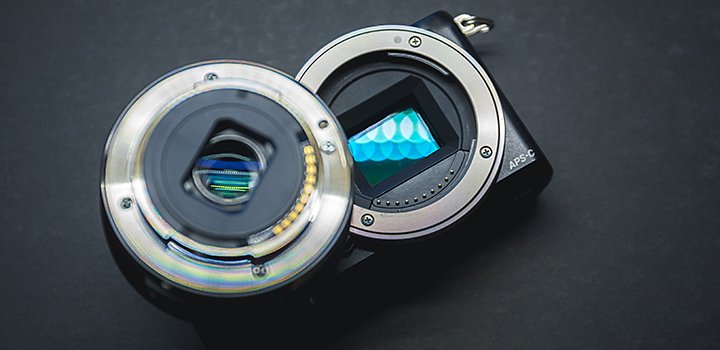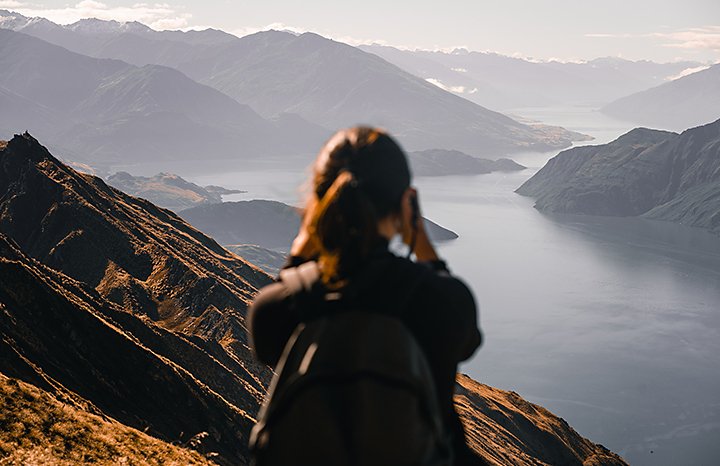Full frame vs. crop sensor: Which format is best for you?
All digital cameras are classified by their sensor size, and the two most popular sizes are cropped and full frame. Learn the differences between each type, so you can pick the best camera for your needs.

Getting a sense for camera sensors.
To decide what digital camera you want to buy or use, one of the first and most important decisions you’ll have to make is what sensor size to use. In the world of digital photography, there are two main categories of cameras: those with cropped sensors and those with full-frame sensors.
There are pros and cons to each sensor size, and depending on your photography goals, you might find that a crop sensor or a full-frame camera is the better option for you. Once you know the features of both, you can confidently pick the right setup for the job.
Full-frame and crop sensors explained.
The sensor is the physical rectangle in the center of your DSLR camera that reads the image from the lens. Generally, the larger the sensor, the more light and detail you are able to capture, and the higher your image quality will be. A full-frame camera has a sensor the size of a 35mm film camera (24mm x 36mm).

How a crop sensor works.
A crop sensor is smaller than the standard 35mm size, which introduces a crop factor to the photos these cameras take. This means that the edges of your photo will be cropped for a tighter field of view. For example, if you use a 50mm lens on a crop sensor camera with a multiplier effect of 1.5x, your effective focal length will be the same as a 75mm lens.
“Different camera bodies have different crop factors,” says photographer Whitney Whitehouse. “Canon has a 1.6x crop sensor, while Nikon, Sony, Sigma, and Pentax have a multiplier of 1.5x, and Panasonic and Olympus are 2x.”
To find the equivalent angle of view for a lens on a crop sensor body, simply multiply the magnification amount by the focal length of the lens. The two most common crop sensor sizes are APS-C and Micro Four Thirds, which have a 1.6x and 1.5x crop factor respectively.
Advantages of full-frame cameras.
Dynamic range
Dynamic range refers to the complete range of exposure values in an image, from its darkest areas to its lightest. Newer full-frame DSLRs will give you the highest dynamic range. This means you can shoot higher contrast images. It also means that if you accidentally underexpose or overexpose your image, a full-frame file (especially if you shoot in RAW) will give you the latitude to recover blown-out highlights or deep shadows more than a crop sensor can.


“You can’t achieve the same low-light performance with a crop sensor that you can with full frame; full frame is so much sharper, clearer, and gives you less noise and more detail,” says photographer Felipe Silva.
Astrophotography is one low-light scenario where the larger sensor really shines. “It’s very hard to get a good night sky shot with a crop sensor because the sensor is smaller, meaning it lets in less light, and it’s already dark as it is,” says Silva.
High ISO performance goes hand in hand with low-light capabilities. Because more light hits the bigger sensor, you don’t have to crank up your ISO as much to compensate for the lack of light, and thereby degrade your shot with the grainy noise associated with high ISOs.


Shallow depth of field
While depth of field is largely determined by your lens and its maximum aperture, the camera body can help you achieve that beautiful blurred bokeh effect as well. Full-frame sensors allow for a shallower depth of field than their cropped counterparts.
Portraiture, food photography, and other types of photography that benefit from a blurred background will be best served by a full-frame sensor.
A camera isn’t the sole factor in determining image quality, but a full-frame sensor will get you a solid start. If you are a commercial photographer or need to print photos at large sizes, a full-frame sensor will help you meet the highest standards for resolution and detail. More megapixels also means you can significantly crop an image and still come away with a usable frame.

Wider field of view
Because there’s no crop factor on full-frame sensors, “you’re able to get a wider field of view with your lens,” says Whitehouse. “If you shoot landscape photography or anything that needs a wide frame, such as real estate photography or architecture, you’ll probably want a full frame.”
Disadvantages of shooting full frame.
Expensive
Full-frame cameras are designed to meet the needs of enthusiasts and working professionals, and their higher price tags reflect these extra features. Keep in mind that if you choose a full-frame camera you’ll have to invest in full-frame lenses, which can be just as expensive as, if not pricier than, the body itself.
Even as mirrorless cameras continue to make great strides toward slimmer full-frame bodies, there’s no getting around the added bulk of a full-frame camera. This is in part due to the size of the sensor. If you want to take your camera on the road for travel photography, street photography, or photojournalism, full-frame lenses and bodies can be unwieldy to lug around.
More pixels means bigger files. This means you’ll have to invest in the appropriate storage to house these larger files, from faster memory cards to cloud storage or backup drives.
Advantages of crop sensor cameras.
More versatile size
“If you’re not ready to drop the cash for a full frame, it’s better to start with a crop sensor, which is also smaller and lighter. And mirrorless crop sensor cameras are so small that if you need something super portable, a crop sensor is great,” says Whitehouse.

Crop factor
While the crop factor can be seen as a weakness of these cameras, you can also turn this magnification to your advantage in scenarios where you need to get as close as possible. “The crop sensor’s smaller sensor gives your lenses extra reach. If you shoot wildlife photography or sports photography, you can do pretty well with a crop sensor camera,” says Silva.
Disadvantages of crop sensors.
Lower image quality
A crop sensor can’t fit the same amount of information into a file as a full frame simply due to its smaller surface area. But in practice this may only become noticeable in certain situations, such as low-light conditions. As camera technology advances, the quality gap between crop sensors and full frames will continue to close.
The crop factor can be a handy hack to amplify your telephoto reach, but the flip side is that shooting wide-angle shots is difficult. “Because you’re zoomed in with a crop sensor, it’s really hard to back out,” says Silva. “You’d need a very wide angle lens to get everything around you in a crop sensor, but there’s a lot of distortion with lenses that wide.”

How to get the most out of any camera.
No matter what type of camera you opt for, here are a few practices you can adopt to get the best shot possible with the gear you’ve got.
“If you’re going to use a crop sensor, the best thing you can do for yourself is invest in a full-frame lens,” says Silva. “At the end of the day, the glass is more important than anything.” Lenses tend to hold their value better than camera bodies and are equally, if not more, responsible for the image quality you can get out of your camera.
“You can use a full-frame lens on a crop sensor, but not the other way around,” adds Whitehouse. If you want to save money on a crop sensor but think you might upgrade to a full frame later, it’ll be less expensive in the long run to invest in quality glass now. This will help you to easily scale up your kit without having to sell and replace costly items.
Uncompressed RAW files capture much more information than a compressed JPG, but the good news is that both crop and full-frame sensor cameras can shoot RAW. To maximize your image quality, shoot in RAW whenever possible. With RAW files, you can recover highlights and shadows in post that would be lost if left to JPGs.
The camera doesn’t make the photographer.
At the end of the day a camera is a tool, much like a paintbrush is to a painter. You can make a good photo with your smartphone or with a $10,000 Leica, but the most important parts of photography come down to your eye as the photographer. Consider the basic blueprints of strong visuals, such as light, composition, color, and contrast, and you can come away with a good photo no matter what camera you have in your hand.
Which sensor size is right for you?
While full frames will almost always be considered the industry standard for working professionals, there are so many great camera options that the decision between the two often comes down to the individual photographer’s needs and goals.
“Crop sensor cameras are getting so good that image quality alone isn’t enough of a reason to choose a full frame over crop sensor,” says Whitehouse. In many cases, a full frame might be more camera than you need — at least right now. Know your needs and from there weigh the pros and cons of each option.
“The most important thing is to assess what you’re taking images of,” says Whitehouse. “Many people shoot full frame who don’t need to. A crop sensor is a good place to start because you get great quality at a lower price point.”
Now that you know the ins and outs of sensor sizes, you’re ready to pick the camera that best suits your style. Remember that technical specs are important, but they’re not everything; if the camera inspires you to get out and shoot, it’s the one for you.
Contributors
Do more with Adobe Photoshop Lightroom.
Edit photos easily with Lightroom presets, Super Resolution, easily share photos from any device, and access your projects anywhere with cloud photo storage management.
You might also be interested in…
Night Photography.
Low light doesn’t have to equal low quality with these tips for successful nighttime photos.
Lightroom vs. Photoshop: When to use each image editing program.
Learn the differences between these industry-leading photo editors and discover your ideal editing workflow.
Get started in commercial photography.
Learn about commercial photography, and get tips for working with clients and tackling your shoot.
The basics of the DSLR camera.
Learn more about the pros and cons of this type of digital camera.
Lightroom प्लान
कहीं से भी फ़ोटो संपादित करें, व्यवस्थित करें, संग्रहीत करें और साझा करें।
7 दिन मुफ़्त, फिर ₹797.68/माह।
फ़ोटोग्राफ़ी
Lightroom, Lightroom Classic, Photoshop और 20GB का क्लाउड स्टोरेज पाएँ। 7 दिनों के लिए मुफ़्त, फिर ₹797.68/माह।
All Apps
सभी 20+ क्रिएटिव डेस्कटॉप व मोबाइल ऐप्स पाएँ।
7 दिन मुफ़्त, उसके बाद₹4,230.30/माह।



